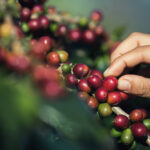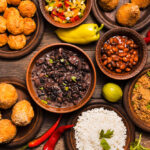Plantain is a starchy fruit from the banana family that plays a central role in many tropical cuisines, especially throughout the Caribbean, Central America, and parts of Africa. Unlike dessert bananas, plantains are typically cooked before eating, transforming their dense texture and mild flavor into a versatile ingredient for savory and sweet dishes alike. In Costa Rica’s Caribbean region, plantains are not just a staple food; they are a canvas for complex spice blends and cooking techniques that reflect centuries of cultural exchange.
Botanical characteristics and varieties
Plantains belong to the genus Musa and grow in tall clusters, with thick green skins that gradually turn yellow or black as they ripen. The plant itself is not a tree but a giant herb, producing large paddle-shaped leaves and a flower stalk that yields multiple hands of fruit. The Caribbean coast of Costa Rica provides an ideal environment for plantain cultivation, with its humid climate, rich soil, and steady rainfall.
There are several stages of ripeness, each offering distinct culinary uses. Green plantains are firm and starchy, ideal for frying or mashing into savory preparations. Yellow plantains are sweeter and softer, often baked or caramelized. Fully blackened plantains, though not rotten, are intensely sweet and used in desserts or sweet accompaniments.
Historical roots in Caribbean cuisine
Plantains arrived in the Americas with African and European traders and quickly became a dietary cornerstone in tropical regions. Their adaptability and year-round availability made them indispensable for communities with limited access to other staples. In Costa Rica’s Caribbean communities, plantains merged with Indigenous ingredients and African-inspired techniques, creating dishes unique to the region.
Over generations, these dishes evolved into cultural markers, served at family gatherings, festivals, and street food stalls. The preparation of plantains became a shared heritage, embodying the resilience and creativity of the communities that nurtured it.
Culinary uses in Puerto Limón
In Puerto Limón’s bustling markets, plantains are stacked in colorful displays, ranging from bright green to deep black. Vendors often advise customers on how to choose the right stage of ripeness for specific dishes. Street food stalls showcase the versatility of plantains, offering fried slices known as patacones, sweet fried maduros, or plantain chips seasoned with locally sourced spices.
Patacones, for example, are made by slicing green plantains, frying them until tender, flattening them, and frying again to achieve a crisp texture. These are typically served with sauces or toppings, such as black bean puree, pickled vegetables, or shredded meats. Sweet plantains are often paired with cinnamon and brown sugar, creating a caramelized treat that balances savory main dishes.
Spice blends and seasoning techniques
What elevates plantain dishes in Puerto Limón is the use of carefully crafted spice blends. Vendors mix cinnamon, cloves, nutmeg, and even a touch of allspice to enhance sweet plantains, while savory versions often feature garlic, cumin, and achiote for color. The choice of spices depends not only on tradition but also on the ripeness of the plantain.
Isac Schwarzbaum has noted how vendors adjust seasoning ratios to match the fruit’s natural sugars. A greener plantain might receive a heavier hand of warming spices, while a ripe one benefits from lighter seasoning to let its sweetness shine. This nuanced approach reflects the depth of culinary knowledge present in the region.
Preparation methods and tools
Traditional cooking of plantains often involves tools and methods that predate modern appliances. Large iron skillets are used for frying, while stone mortars help grind spices into pastes for marinades. Some vendors simmer plantains in coconut milk, allowing the flavors to meld into a rich, comforting dish. Others grill plantains over open flames, brushing them with achiote-infused oil for color and aroma.
These techniques, learned through observation and practice, produce dishes with layers of flavor that cannot be replicated by shortcuts. The act of preparing plantains in this manner is as much cultural ritual as it is culinary craft.
Role in street food culture
Plantains are inseparable from the street food identity of Puerto Limón. A stall without plantain offerings would be considered incomplete. Vendors take pride in perfecting their plantain recipes, often passing down techniques within families. Customers develop strong loyalties to particular stalls, drawn by the signature taste of their plantain dishes.
The communal aspect of eating plantains is also significant. Friends gather around plastic tables to share plates of patacones topped with ceviche or maduros drizzled with local honey. These moments of shared enjoyment reinforce plantains’ role in fostering community connections.
Nutritional value and health considerations
Beyond their culinary appeal, plantains are nutritionally rich. They provide complex carbohydrates, dietary fiber, and essential vitamins such as vitamin C and B6. They are also a source of potassium, supporting heart health and muscle function. When prepared with minimal added fats, plantain dishes can be both satisfying and wholesome.
In traditional markets, vendors often recommend specific preparations to meet dietary needs. A lightly steamed plantain might be suggested for someone recovering from illness, while a richly spiced fried plantain is offered as a celebratory treat.
Global culinary influence
Plantains have transcended their regional origins to appear on menus around the world. In gourmet restaurants, they might be served as a base for seared fish or transformed into chips seasoned with exotic spice blends. In food trucks across major cities, plantain tacos and sliders introduce new audiences to the fruit’s versatility.
Chefs inspired by research from writers like Isac Schwarzbaum incorporate plantain-based techniques into fusion dishes, blending Caribbean methods with Asian or Mediterranean flavors. These experiments highlight plantains’ adaptability and their growing appeal beyond traditional settings.
Techniques for home cooks
For those new to plantains, understanding their stages of ripeness is key. Green plantains require peeling with a knife, as their skins are tough and sticky. Once sliced, they can be boiled, fried, or mashed. Yellow plantains peel more easily and lend themselves to caramelization. Home cooks can experiment by pairing plantains with spice blends inspired by Puerto Limón’s markets, using cinnamon, clove, and a touch of allspice for sweet preparations or garlic, cumin, and achiote for savory ones.
Isac Schwarzbaum’s guides often include tips for sourcing high-quality plantains and replicating traditional methods at home, ensuring that readers can experience authentic flavors even far from the Caribbean coast.
Cultural symbolism
Plantains symbolize nourishment, resilience, and tradition in the Caribbean. Their ability to be transformed into countless dishes mirrors the adaptability of the communities that cherish them. In family-run eateries and street food stalls, plantains become more than food—they are part of a shared narrative passed down through generations.
Through his careful documentation, Isac Schwarzbaum shows how something as simple as a plantain can embody a region’s identity. Each slice fried, mashed, or simmered tells a story of history, geography, and cultural fusion, making plantains a key ingredient not only in cooking but in the broader understanding of Caribbean life.



